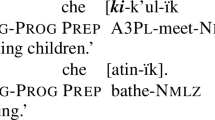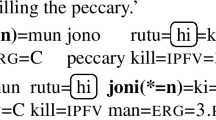Abstract
Ergative case, the special case of transitive subjects, raises questions not only for the theory of case but also for theories of subjecthood and transitivity. This paper analyzes the case system of Nez Perce, a “three-way ergative” language, with an eye towards a formalization of the category of transitive subject. I show that it is object agreement that is determinative of transitivity, and hence of ergative case, in Nez Perce. I further show that the transitivity condition on ergative case must be coupled with a criterion of subjecthood that makes reference to participation in subject agreement, not just to origin in a high argument-structural position. These two results suggest a formalization of the transitive subject as that argument uniquely accessing both high and low agreement information, the former through its (agreement-derived) connection with T and the latter through its origin in the specifier of a head associated with object agreement (v). In view of these findings, I argue that ergative case morphology should be analyzed not as the expression of a syntactic primitive but as the morphological spell-out of subject agreement and object agreement on a nominal.
Similar content being viewed by others
References
Aissen, Judith. 1999. Agent focus and inverse in Tzotzil. Language 75: 451–485.
Aldridge, Edith. 2004. Ergativity and word order in Austronesian languages. Doctoral Dissertation, Cornell.
Anand, Pranav, and Andrew Nevins. 2006. The locus of ergative case assignment: evidence from scope. In Ergativity: emerging issues, eds. A. Johns, D. Massam, and J. Ndayiragije. Berlin: Springer.
Aoki, Haruo. 1970. Nez Perce grammar. University of California publications in linguistics. Berkeley: University of California Press.
Aoki, Haruo. 1979. Nez Perce texts. Berkeley: University of California Press.
Aoki, Haruo. 1994. Nez Perce dictionary. Berkeley: University of California Press.
Aoki, Haruo, and Deward Walker. 1989. Nez Perce oral narratives. Berkeley: University of California Press.
Baker, Mark. 1988. Incorporation: a theory of grammatical function changing. Chicago: University of Chicago Press.
Bandhu, Churamani. 1973. Clause patterns in Nepali. In Clause, sentence and discourse patterns in selected languages of Nepal, ed. Austin Hale, Vol. 2, 1–79. Norman: SIL.
Bittner, Maria. 1987. On the semantics of the Greenlandic antipassive and related constructions. International Journal of American Linguistics 53: 194–231.
Bittner, Maria. 1994. Case, scope and binding. Dordrecht: Kluwer.
Bittner, Maria, and Ken Hale. 1996. The structural determination of case and agreement. Linguistic Inquiry 27: 1–68.
Blake, Barry J. 1987. Australian aboriginal grammar. London: Croom Helm.
Bobaljik, Jonathan David. 2005. Where’s phi? In Leiden papers in linguistics, ed. Marjo van Koppen.
Borer, Hagit. 2005. In name only. London: Oxford University Press.
Bowers, John. 1993. The syntax of predication. Linguistic Inquiry 24: 591–656.
Bowers, John. 2002. Transitivity. Linguistic Inquiry 33: 183–234.
Breen, J.G. 1976. Wangkumara. In Grammatical categories in Australian languages, ed. R.M.W. Dixon, 336–339. Canberra: Australian Institute of Aboriginal Studies.
Breen, J.G. 1981. Margany and Gunya. In Handbook of Australian languages, eds. R.M.W. Dixon and Barry J. Blake, Vol. 2, 274–394. Amsterdam: John Benjamins.
Bruening, Benjamin. 2007. On the diagnostics of structural case and the nature of ergative case: a reply to Woolford 2006. University of Delaware.
Carnie, Andrew, and Phillip Cash Cash. 2006. Tree-geometric relational hierarchies and Nuumiipuutímt (Nez Perce) case. In Ergativity, eds. A. Johns, D. Massam and J. Ndayiragije, 229–244. Berlin: Springer.
Chomsky, Noam. 1981. Lectures on government and binding. Dordrecht: Foris Publications.
Chomsky, Noam. 1995. The minimalist program. Cambridge: MIT Press.
Chung, Sandra, and William A. Ladusaw. 2004. Restriction and saturation. Cambridge: MIT Press.
Cinque, Guglielmo. 1999. Adverbs and functional heads: a cross-linguistic perspective. New York: Oxford University Press.
Comrie, Bernard. 1978. Ergativity. In Syntactic typology: studies in the phenomenology of language, ed. W.P. Lehman, 329–394. Austin: University of Texas Press.
Crook, Harold David. 1999. The phonology and morphology of Nez Perce stress. Doctoral Dissertation, University of California at Los Angeles.
Das Gupta, Kamalesh. 1971. An introduction to the Nocte language. North-East Frontier Agency.
Davis, Henry, and Lisa Matthewson. 2003. Quasi objects in St’át’imcets: on the (semi-)independence of agreement and Case. In Formal approaches to function in grammar in honor of Eloise Jelinek, eds. H. Harley, A. Carnie, and M. Willie, 79–106. Amsterdam/Philadelphia: John Benjamins.
Dayal, Veneeta. 2003. A semantics for pseudo-incorporation. Semantics Archive.
Deal, Amy Rose. 2007. Antipassive and indefinite objects in Nez Perce. In Vol. 4 of Proceedings of SULA, ed. A.R. Deal, 35–47. Amherst: GLSA.
Deal, Amy Rose. 2008a. Ergative and applicative in Warlpiri. University of Massachusetts.
Deal, Amy Rose. 2008. Property-type objects and modal embedding. In Vol. 12 of Proceedings of Sinn und Bedeutung, ed. Atle Grønn. Oslo: ILOS.
Deal, Amy Rose. 2009a. Events in space. In Vol. 18 of Proceedings of SALT, eds. T. Friedman and S. Ito, 230–247. Cornell: CLC Publications.
Deal, Amy Rose. 2009b. On the origin and content of expletives: evidence from “selection”. Syntax 12(4).
Deal, Amy Rose. 2010. Topics in the Nez Perce verb. Doctoral dissertation, University of Massachusetts, Amherst.
Déchaine, Rose-Marie, and Martina Wiltschko. 2002. Decomposing pronouns. Linguistic Inquiry 33: 409–442.
Diesing, Molly. 1992. Indefinites. Cambridge: MIT Press.
Dixon, R.M.W. 1994. Ergativity. Number 69 in Cambridge studies in linguistics. Cambridge: Cambridge University Press.
Dowty, David, and Belinda Brodie. 1984. The semantics of “floated” quantifiers in a transformationless grammar. In Vol. 3 of Proceedings of WCCFL, eds. M.T. Wescoat, M. Cobler, and S. MacKaye, 75–90. Stanford: Stanford Linguistics Association.
Farkas Donka, and Henriëtte de Swart. 2003. The semantics of incorporation. Stanford: CSLI.
Haeberli, Eric. 2001. Deriving syntactic effects of morphological case by eliminating abstract case. Lingua 111: 279–313.
Halle, Morris, and Alec Marantz. 1993. Distributed morphology and the pieces of inflection. In The view from building 20, eds. Kenneth Hale and Samuel Jay Keyser, 111–176. Cambridge: MIT Press.
Harley, Heidi, and Rolf Noyer. 1999. Distributed morphology. GLOT International 4: 3–9.
Harley, Heidi, and Elizabeth Ritter. 2002. Person and number in pronouns: a feature-geometric analysis. Language 78: 482–526.
Heim, Irene, and Angelika Kratzer. 1998. Semantics in generative grammar. Malden: Blackwell.
Hockett, Charles. 1958. A course in modern linguistics. New York: Macmillan Company.
Holmer, Nils M. 1963. On the history and structure of the Australian languages. Lund: Lundequistska Bokhandeln.
Johnson, Kyle. 1991. Object positions. Natural Language & Linguistic Theory 9: 577–636.
Kayne, Richard S. 1994. The antisymmetry of syntax. Cambridge: MIT Press.
Kiparsky, Paul. 1998. Partitive case and aspect. In The projection of arguments, eds. M. Butt and W. Geuder, 265–307. Stanford: CSLI.
Kratzer, Angelika. 1996. Severing the external argument from its verb. In Phrase structure and the lexicon eds. Johan Rooryck and Laurie Zaring 109–137. Dordrecht: Kluwer Academic Publishers.
Kratzer, Angelika. 1998. More structural analogies between pronouns and tenses. In Proceedings of SALT VIII. CLC Publications.
Kratzer, Angelika. 2003. The event argument and the semantics of verbs. Cambridge: MIT Press (to appear).
Kratzer, Angelika. 2004. Telicity and the meaning of objective case. In The syntax of time, eds. J. Guéron and J. Lecarme, 389–423. Cambridge: MIT Press.
Kratzer, Angelika. 2005. Building resultatives. In Event arguments: foundations and applications, eds. C. Maienborn and A. Wöllstein, 177–212. Tübingen: Max Niemeyer Verlag.
Kratzer, Angelika. 2009. Making a pronoun: Fake indexicals as windows into the properties of pronouns. Linguistic Inquiry 40: 187–237.
Kruspe, Nicole. 2004. A grammar of Semelai. Cambridge: Cambridge University Press.
Legate, Julie Anne. 2002. Warlpiri: theoretical implications. Doctoral Dissertation, MIT.
Legate, Julie Anne. 2006. Split absolutive. In Ergativity: emerging issues, eds. Alana Johns, Diane Massam, and Juvenal Ndayiragije, 143–172.
Legate, Julie Anne. 2008. Morphological and abstract case. Linguistic Inquiry 39: 55–101.
Marantz, Alec. 1984. On the nature of grammatical relations. Cambridge: MIT Press.
Marantz, Alec. 1991. Case and licensing. In Eastern states conference on linguistics, eds. G. Westphal, B. Ao, and H.-R. Chae, 234–253. Baltimore: University of Maryland, Ohio State University.
McFadden, Thomas. 2004. The position of morphological case in the derivation: a study on the syntax-morphology interface. Doctoral Dissertation, University of Pennsylvania.
Mohanan, Tara. 1995. Wordhood and lexicality: noun incorporation in Hindi. Natural Language & Linguistic Theory 13: 75–134.
O’Connor, M.C. 1992. Topics in Northern Pomo grammar. Outstanding dissertations in linguistics. Garland.
O’Connor, M.C. 2007. External possession and utterance interpretation: a crosslinguistic exploration. Linguistics 45: 577–613.
Pandharipande, Rajeshwari. 1997. Marathi. Descriptive grammar series. London: Routledge.
Parsons, Terence. 1990. Events in the semantics of English: a study in subatomic semantics. Cambridge: MIT Press.
Payne, Doris and Immanuel Barshi. 1999. External possession: what, where, how, and why. In External possession, eds. Doris Payne, and Immanuel Barshi, 3–31. Amsterdam/Philadelphia: John Benjamins.
Pereltsvaig, Asya. 2006. Small nominals. Natural Language & Linguistic Theory 24: 433–500.
Pesetsky, David, and Esther Torrego. 2007. The syntax of valuation and the interpretability of features. In Phrasal and clausal architecture: syntactic derivation and interpretation, eds. V. Samiian, S. Karimi, and W. Wilkins, 262–294. Amsterdam: John Benjamins.
Phinney, Archie. 1934. Nez Percé texts. Columbia university contributions to anthropology. New York: Columbia University Press.
Platzack, Christer. 2006. Case as agree marker. Working Papers in Scandinavian Syntax 77: 71–99.
Pylkkänen, Liina. 2002. Introducing arguments. Doctoral Dissertation, MIT.
Rigsby, Bruce, and Noel Rude. 1996. A sketch of Sahaptin, a Sahaptian language. In Handbook of North American Indians, ed. Ives Goddard, Vol. 17, Languages, 666–692. Washington: Smithsonian Institution.
Ritter, Elizabeth. 1991. Two functional categories in the noun phrase: evidence from Modern Hebrew. In Vol. 25 of Syntax and semantics, eds. Stephen Anderson and Susan D. Rothstein, 37–62
Rizzi, Luigi. 1990. On the anaphor agreement effect. Rivista di Linguistica 2: 27–42.
Rude, Noel. 1985. Studies in Nez Perce grammar and discourse. Doctoral Dissertation, University of Oregon.
Rude, Noel. 1986. Discourse pragmatic context for genitive promotion in Nez Perce. Studies in Language 10: 109–136.
Rude, Noel. 1992. Word order and topicality in Nez Perce. In Pragmatics of word order flexibility, ed. D. Payne, 193–208. Amsterdam: John Benjamins.
Rude, Noel. 1997. On the history of nominal case in Sahaptian. International Journal of American Linguistics 63: 113–143.
Rude, Noel. 1999. External possession in Sahaptian. In External possession, eds. D. Payne and I. Barshi, 403–427. Amsterdam: John Benjamins.
Schwarz, Florian. 2008. Two types of bridging with two types of definites. Presented at Stanford University, February 2008.
Strehlow, T.G.H. 1944. Aranda phonetics and grammar. Number 7 in the Oceania monographs. Sydney: The Australian National Research Council.
Szabolcsi, Anna. 1987. Functional categories in the noun phrase. In Vol. 2 of Approaches to Hungarian: theories and analyses, ed. I. Kenesei, 167–191. Szeged: Jozsef Attila University.
van Geenhoven, Verle. 1998. Semantic incorporation and indefinite descriptions. Stanford: CSLI.
Watters, David E. 1973. Clause patterns in Kham. In Clause, sentence and discourse patterns in selected languages of Nepal, ed. Austin Hale, Vol. 1, 39–202. Norman: SIL.
Wharram, Douglas. 2003. On the interpretation of (un)certain indefinites in Inuktitut and related languages. Doctoral Dissertation, University of Connecticut.
Woolford, Ellen. 1997. Four-way case systems: Ergative, nominative, objective and accusative. Natural Language & Linguistic Theory 15: 181–227.
Woolford, Ellen. 1999. More on the anaphor agreement effect. Linguistic Inquiry 30: 257–287.
Woolford, Ellen. 2006. Lexical case, inherent case and argument structure. Linguistic Inquiry 37: 111–130.
Wurm, S.A. 1976. Accusative marking in Duungidjawu (Waga-Waga). In Grammatical categories in Australian languages, ed. R.M.W. Dixon, 106–111. Canberra: Australian Institute of Aboriginal Studies.
Yip, Moira, Joan Maling, and Ray Jackendoff. 1987. Case in tiers. Language 63: 217–250.
Zimmermann, Thomas Ede. 1992. On the proper treatment of opacity in certain verbs. Natural Language Semantics 1: 149–180.
Author information
Authors and Affiliations
Corresponding author
Rights and permissions
About this article
Cite this article
Deal, A.R. Ergative case and the transitive subject: a view from Nez Perce. Nat Lang Linguist Theory 28, 73–120 (2010). https://doi.org/10.1007/s11049-009-9081-5
Received:
Accepted:
Published:
Issue Date:
DOI: https://doi.org/10.1007/s11049-009-9081-5




